Over the past several weeks, I’ve been lucky enough to find some amazing critters and enjoy some beautiful wildflowers. In this week’s article, I just wanted to share some of the recent nature-related discoveries I made in my backyard and community.
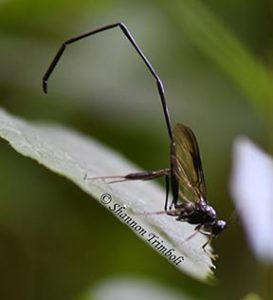
This weird looking wasp is an American pelecinid wasp (Pelecinus polyturator). I discovered it on a walk around our property. When I first caught a glimpse of it out of the corner of my eye, I almost dismissed it as some sort of cranefly. But when I turned and actually LOOKED at it, I knew it was some kind of new-to-me wasp. As soon as I got back to the house, I had to look it up.
The American pelecinid wasp is the only species of its genus that is found in North America! And although its “stinger” may look intimidating, it can’t sting because it doesn’t have a stinger. The long stinger-looking thing is actually her abdomen. The females will insert their abdomens into the ground to lay an egg on a beetle grub. I still have lots to learn about this cool wasp and will almost certainly be writing a blog article about it at some point, but for now, I just wanted to share this amazing discovery.
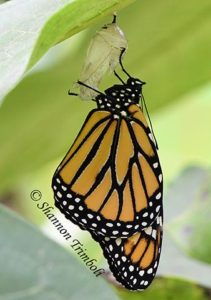
Towards the beginning of the month, a friend invited me over to see the monarch chrysalises in her milkweed garden. (Monarch caterpillars usually crawl away from the milkweed they were feeding on and form their chrysalises on some other vegetation or structure. Evidently, hers hadn’t read the book, because she had quite a few chrysalises on her milkweed.)
Anyway, while I was there, one of the chrysalises turned clear which is a sign that the monarch is about to eclose (the scientific term for when a butterfly emerges from its chrysalis). I tried to film it, but my camera wasn’t recording like I thought it was. It was still amazing to watch. This was the first time I’d been able to watch a wild butterfly eclose.
If you haven’t guessed by now, I love learning new things! I always thought that the only caterpillars that ate milkweed were monarch caterpillars and milkweed tussock moth caterpillars. But, while waiting for the monarch to eclose, I saw this guy / gal chowing down on a common milkweed leaf! It definitely wasn’t a monarch or a milkweed tussock moth, but beyond that, I wasn’t sure. It reminded me of a large, solid-colored woolly worm, but woolly worms don’t eat milkweed.
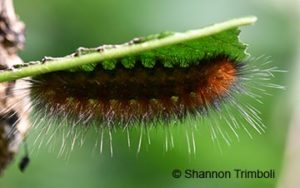
I posted this picture to a caterpillar identification group and was told it was probably a Virginian tiger moth (Spilosoma virginica). I immediately thought to myself, “Oh…. That’s why it looked like a woolly worm.” (Our familiar woolly worms are the caterpillars of the Isabella tiger moth. Both species are in the same family but different genera.) Virginian tiger moth caterpillars eat a wide variety of plants, and at least one reference states that they are frequently found on common milkweed in southeast Michigan. Apparently, they also like common milkweed in Kentucky.
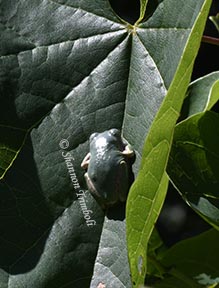
Sometimes you have to look closely to see the wildlife in your backyard. This gray treefrog blends in almost perfectly with the leaf it is resting on. In the eastern U.S. we have two gray treefrogs – the eastern gray treefrog (Hyla versicolor) and Cope’s gray treefrog (Hyla chrysoscelis). The two species are really hard to tell apart and both can change colors depending on their surroundings. The most reliable way to tell them apart without looking at their DNA is by call and this one was just chilling out in silence.
I was super excited the other day when my husband told me that he thought there was a Carolina mantis in our yard. Our native mantid isn’t as common as the introduced ones, so I quickly ran outside with my camera and despite the windy conditions was able to get a few pictures.
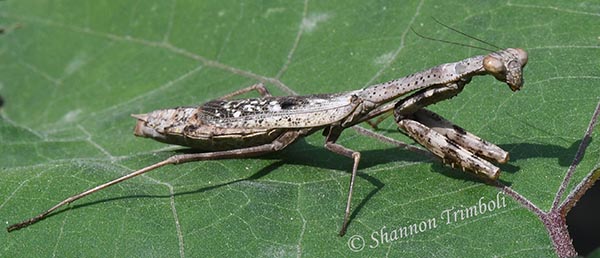
The Carolina mantis (Stagmomantis carolina) is our only native praying mantis in the eastern U.S. The other two praying mantis species that are found here are the European mantis (Mantis religiosa) and the Chinese mantis (Tenodera sinensis). Both are larger and more common than our native Carolina mantis. (Chinese mantids are the really big, green praying mantis that people find in their yards and often think of when someone says “praying mantis.”)
We’ve seen it or other Carolina mantis several times since then. We never see more than one at a time so I’m not sure whether we are seeing the same one over and over again, or multiple different individuals. She / they look awfully fat every time we see them, so I’m hoping we’ll have more native mantids next year.
Recently, the native, white, fall asters have really started to bloom. Bees of all types love the fall asters and many of the white fall asters are a good example of some of the amazing signaling adaptations that have evolved between plants and their pollinators.
When seen from a distance the native, white, fall asters can look like a snow drift of white flowers beckoning pollinators to a bountiful feast. However, look closer and you may notice that not all of the flowers look the same. Some of the flowers may have bright yellow centers, while others have reddish colored centers.
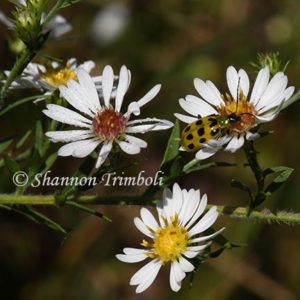
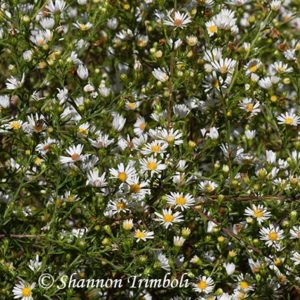
The reddish colored centers are on flowerheads that are no longer producing nectar and pollen (presumably because they have already been adequately pollinated). The yellow centers are on flowerheads that still need to be pollinated and are actively producing nectar and pollen.
All of the flowers work together to create a large visual display that shouts, “Hey pollinator! Look over here! See all the yumminess we have for you!” Then as the pollinator gets closer, the color of each flowerhead’s center guides the pollinator to individual flowers that still need pollinating and are providing the rewards (pollen and/or nectar) that the pollinator is searching for.
I hope you have enjoyed reading about some of my recent nature-related discoveries from my backyard and community. What are some of your recent nature-related discoveries? Please let us know about them by sharing your nature-related discoveries in the comments below.

Backyard Ecology: Exploring Nature in Your Backyard
Nature isn’t just “out there.” It’s all around us, including right outside our doors. Hi, my name is Shannon Trimboli, and I am the host of Backyard Ecology. I live in southcentral Kentucky and am a wildlife biologist, educator, author, beekeeper, and owner of a nursery specializing in plants for pollinators and wildlife conservation. I invite you to join me as we ignite our curiosity and natural wonder, explore our yards and communities, and improve our local pollinator and wildlife habitat. Learn more or subscribe to my email list at www.backyardecology.net.

Leave a Reply